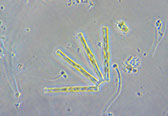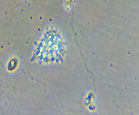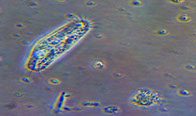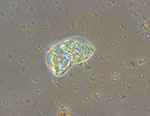
Dr Joe D Taylor: Molecular and Microbial ecology lab






PUBLICATIONS (Significant since 2014)
1. Cronin-O’Reilly S, Taylor J.D, Jermyn IA, Allcock L. Cunliffe, M., Johnson M. 2018 Limited congruence exhibited across microbial, meiofaunal and macrofaunal benthic assemblages in a heterogeneous coastal environment Scientific reports IF=4.122
2. Liu, X., Burslem, D.F., Taylor, J.D., Taylor, A.F., Khoo, E., Majalap‐Lee, N., Helgason, T. and Johnson, D., 2018. Partitioning of soil phosphorus among arbuscular and ectomycorrhizal trees in tropical and subtropical forests. Ecology letters. https://doi.org/10.1111/ele.12939 IF=10.689
3. Smale, D.A., Taylor, J.D., Coombs, S.H., Moore, G. and Cunliffe, M., 2017. Community responses to seawater warming are conserved across diverse biological groupings and taxonomic resolutions. Proc. R. Soc. B, 284(1862), p.20170534. IF= 4.823
4. Taylor, J.D. and Cunliffe, M., 2016. Multi-year assessment of coastal planktonic fungi reveals environmental drivers of diversity and abundance. The ISME journal. The ISME journal. 10(9):2118-28 IF=9.302
5. Taylor, J. D., Cottingham, S. D., Billinge, J., and Cunliffe, M. 2014. Seasonal microbial community dynamics correlate with phytoplankton-derived polysaccharides in surface coastal waters. The ISME journal, 8(1), 245. IF=9.302
10(9):2118-28 IF=9.302
All other publications
1. Dale, H., Taylor, J.D., Solan, M., Lam, P. and Cunliffe, M., 2018. Polychaete mucopolysaccharide alters sediment microbial diversity and stimulates ammonia-oxidising functional groups. FEMS microbiology ecology, 95(2), p.fiy234.
2. Taylor, J.D., Bird, K.E., Widdicome, C.E. and Cunliffe, M., 2018. Active bacterioplankton community response to dissolved ‘free’deoxyribonucleic acid (dDNA) in surface coastal marine waters. FEMS microbiology ecology. https://doi.org/10.1093/femsec/fiy132 IF= 3.875
3. Esmaeilishirazifard, E., Usher, L., Trim, C., Denise, H., Sangal, V., Tyson, G.H., Barlow, A., Redway, K., Taylor, J.D., Kremmyda-Vlachou, M. and Loftus, T.D., 2018. Microbial adaptation to venom is common in snakes and spiders. bioRxiv, p.348433.
4. Lewis, J., Taylor, J.D., Neale, K. and Leroy, S.A., 2018. Expanding known dinoflagellate distributions: investigations of slurry cultures from Caspian Sea sediment. Botanica Marina, 61(1), pp.21-31. IF= 1.239
5. Cunliffe, M., Hollingsworth, A., Bain, C., Sharma, V. and Taylor, J.D., 2017. Algal polysaccharide utilisation by saprotrophic planktonic marine fungi. Fungal Ecology, 30, pp.135-138. IF= 3.1
6. Taylor, J.D, Cunliffe M. (2017) Coastal bacterioplankton community response to diatom-derived polysaccharide microgels Environ. micro. rep 9:151- 157 IF=3.363
7. McNamee, S.E., Medlin, L.K., Kegel, J., McCoy, G.R., Raine, R., Barra, L., Ruggiero, M.V., Kooistra, W.H., Montresor, M., Hagstrom, J., Blanco, E.P., Taylor, J.D et al (2016). Distribution, occurrence and biotoxin composition of the main shellfish toxin producing microalgae within European waters: A comparison of methods of analysis. Harmful Algae, 55, 112-120.IF= 3.54
8. Taylor, J.D. and Cunliffe, M., (2015) Polychaete burrows harbour distinct microbial communities in oil‐contaminated coastal sediments. Environmental microbiology reports, 7(4), pp.606-613 IF=3.363.
9. Taylor, J.D, Cunliffe, M (2014) High-throughput sequencing reveals neustonic and planktonic microbial eukaryote diversity in coastal waters Journal of phycology doi: 10.1111/jpy.12228-14-014 IF=2.239
10. Taylor, J. D., Ellis, R., Milazzo, M., Hall‐Spencer, J. M., & Cunliffe, M. (2014). Intertidal epilithic bacteria diversity changes along a naturally occurring carbon dioxide and pH gradient. FEMS microbiology ecology. doi/10.1111/1574-6941.12368/ IF= 3.720
11. Taylor, J. D., Kegel, J. U., Lewis, J. M., & Medlin, L. K. (2014). Validation of the detection of Alexandrium species using specific RNA probes tested in a microarray format: Calibration of signal using variability of RNA content with environmental conditions. Harmful Algae, 37, 17-27 IF= 3.54
12. Taylor, J. D., Berzano, M., Percy, L., & Lewis, J. (2013). Evaluation of the MIDTAL microarray chip for monitoring toxic microalgae in the Orkney Islands, UK. Environmental Science and Pollution Research, 20(10), 6765-6777.
13. Taylor, J.D., McKew, B. A., Kuhl, A., McGenity, T. J., & Underwood, G. J. (2013).
Microphytobenthic extracellular polymeric substances (EPS) in intertidal sediments fuel both generalist and specialist EPS-degrading bacteria. Limnol. Oceanogr, 58(4), 1463-1480.
14. McKew, B. A., Dumbrell, A. J., Taylor, J. D., McGenity, T. J., & Underwood, G. J. (2013).Differences between aerobic and anaerobic degradation of microphytobenthic biofilm‐derived organic matter within intertidal sediments. FEMS microbiology ecology, 84(3), 495-509.
15. McKew, B.A., Taylor, J.D., McGenity, T.J. & Underwood G.J.C. (2011) Resilience of benthic biofilm communities from a temperate saltmarsh to desiccation and rewetting. ISME Jour. 5: 30-41
16. Hofmann T., Hanlon A.R.M., Taylor J.D., Ball, A.S., Osborn, A.M. & Underwood GJC (2009) Dynamics and compositional changes in extracellular carbohydrates in estuarine sediments during degradation. Mar. Ecol. Prog. Ser. 379:45-58
17. Unsworth R. K. F., Taylor J. D. , Powell A. , Bell J. J. & Smith D. J. (2007) The contribution of parrotfish (scarid) herbivory to ecosystem dynamics in the Indo-Pacific. Estuar. Coast. Shelf Sci. 74: 53-62
BOOK CHAPTERS
• Taylor J.D., Helgason T., Öpik M. Molecular community ecology of Arbuscular Mycorrhizal Fungi. In Dighton, J. and White J.F (eds) The Fungal Community; it’s organization and role in the ecosystem Fourth edition, pp 1-7
• Taylor J.D, Berzano M, Percy L, Lewis J.M. (2013) Preliminary results of the MIDTAL
project: a microarray chip to monitor toxic dinoflagellates in the Orkney Islands. UK In: Lewis, J. M. & Marrett-Davies, F. Bradley, L. (eds) Biological and Geological Perspectives of Dinoflagellates The Micropalaeontological Society, Special Publications. Geological Society, London, 209-216
• Taylor, J.D (2012) “Field sampling for the microarray chip” , “RNA quantification using the Nanodrop®”, “Preparation of cultures for analysis on the chip”,“Preparation of controls”. In Lewis J., Medlin, L., Raine, R (Eds) MIDTAL (Microarrays for the Detection of Toxic Algae): A Protocol for Successful Microarray Hybridisation and Analysis, Koeltz Scientific Books, Germany ISBN 978-3-905997-08-8